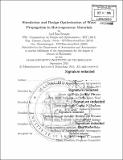Simulation and design optimization of wave propagation in heterogeneous materials
Author(s)
Saà-Seoane, Joel
DownloadFull printable version (25.92Mb)
Other Contributors
Massachusetts Institute of Technology. Department of Aeronautics and Astronautics.
Advisor
Jaume Peraire and Cuong N. Nguyen.
Terms of use
Metadata
Show full item recordAbstract
Propagation of waves through heterogeneous structured materials has been the focus of considerable research in recent years. These materials consist of quasi periodic geometries combining two or more piecewise homogeneous component media. The interest in these materials stems from the fact that when waves propagate through them one can observe phenomena, such as bandgaps, which cannot be obtained with any single homogeneous medium. The design of structured materials aims to identify patterns which have desirable features regarding wave propagation applications. The range of applications is very broad. In the context of electromagnetic waves, governed by Maxwell's equations, one may be interested in the design of low-loss waveguides, invisibility cloaks, superlenses or light frequency filters. For acoustic applications one may consider the design of passive noise filters or sound beams. The physics governing the propagation of waves is well understood and the existing mathematical models often provide excellent predictions. For this reason, the design of structured materials can greatly benefit from the use of numerical simulation and optimization techniques. Accurate numerical simulations can describe the propagation of waves through heterogeneous materials once the geometry and material properties are defined. Optimization methods can help determine arrangements of component materials and their properties in order to optimally accomplish a desired outcome. The work presented in this thesis includes a collection of multiscale high order accurate numerical simulation methods capable of simulating wave propagation in piecewise homogeneous media for two types of problems of interest: the source and the eigenvalue problems. In particular, we introduce the multiscale continuous Galerkin and multiscale hybridizable discontinuous Galerkin methods which exploit the inherent structure of the problem by reusing information from repeated subdomains. The efficiency that these approaches provide (reducing degrees of freedom by a factor of 20 to 100) allows for the numerical solution of large acoustic and electromagnetic wave problems, even in 3d, with a greatly reduced need for computational resources. Furthermore, a discrete topological optimization procedure enhanced with reduced basis approximations is developed in order to facilitate the automated design of these materials. The combination of both methods, simulation and optimization, yields enhanced capabilities for the design of optimal patterns for multiple applications. The design of invisibility cloaks and high transmission waveguide bends in 2d and 3d are considered.
Description
Thesis: Ph. D., Massachusetts Institute of Technology, Department of Aeronautics and Astronautics, 2014. Cataloged from PDF version of thesis. Includes bibliographical references (pages 187-199).
Date issued
2014Department
Massachusetts Institute of Technology. Department of Aeronautics and AstronauticsPublisher
Massachusetts Institute of Technology
Keywords
Aeronautics and Astronautics.